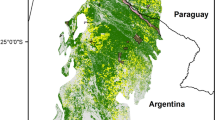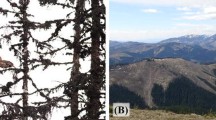Abstract
The abundance of woodland birds in fragmented forest landscapes may depend on the properties of patch networks. Understanding the consequences of deforestation on woodland birds, therefore, necessarily requires determining which changes in landscape structure make a major contribution to the degradation and subdivision of patch networks. In this study, we addressed how accelerated deforestation in central Chile has modified the landscape structure and function for thorn-tailed rayaditos—a woodland specialist bird. Using a graphical approach based on the habitat use and movement patterns of rayaditos, we quantified the reduction of the internal connectivity of components (i.e., connected patch networks) in the last two decades and determined the main mechanisms responsible for this connectivity loss. Forest cover decreased 61.7 % between 1989 and 2009. The component size, the fraction of components with ≥1 occupied patches and the number of patches per component experienced a large decline during the study period. Over time, most forest cover (ca. 80 %) was contained in only two components. The connectivity of components decreased steeply by 90 %. Only the loss of large patches made a highly significant contribution to explaining changes in connectivity, while the removal of stepping stones was marginally significant. The conversion of forest both to shrubland and to peri-urban areas were the only land-use variables explaining connectivity change with effects that changed over time. Conservation measures to ensure persistence of rayaditos populations in central Chile should be focused on the retention of key elements for connectivity.





Similar content being viewed by others
References
Andersson E, Bodin Ö (2009) Practical tool for landscape planning? An empirical investigation of network based models of habitat fragmentation. Ecography 32:123–132
Armesto JJ, Martínez JA (1978) Relationships between vegetation structure and slope aspect in the Mediterranean region of Chile. J Ecol 66:881–889
Armesto JJ, Picket STA (1985) A mechanistic approach to the study of succession in the Chilean matorral. Rev Chil Hist Nat 58:9–17
Awade M, Metzger JP (2008) Using gap-crossing capacity to evaluate functional connectivity of two Atlantic rainforest birds and their response to fragmentation. Aust Ecol 33:863–871
Betts MG, Forbes GJ, Diamond AW, Taylor PD (2006) Independent effects of fragmentation on forest songbirds: an organism-based approach. Ecol Appl 16:1076–1089
Binzenhöfer B, Bierdermann R, Settele J, Schröder B (2008) Connectivity compensates for low habitat quality and small patch size in the butterfly Cupido minimus. Ecol Res 23:259–269
Bodin Ö, Norberg J (2007) A network approach for analyzing spatially structured populations in fragmented landscape. Landsc Ecol 22:31–44
Bodin Ö, Saura S (2010) Ranking individual habitat patches as connectivity providers: integrating network analysis and patch removal experiments. Ecol Model 221:2393–2405
Bodin Ö, Tengö M, Norman A, Lundberg J, Elmqvist T (2006) The value of small size: loss of forest patches and ecological thresholds in southern Madagascar. Ecol Appl 16:440–451
Burnham KP, Anderson DR (2002) Model selection and inference. Springer, Berlin
Chavez PS (1996) Image-based atmospheric corrections. Revisited and improved. Photogramm Eng Remote Sens 62:1025–1036
Chetkiewicz CL, St Clair CC, Boyce MS (2006) Corridors for conservation: integrating pattern and process. Annu Rev Ecol Evol Syst 37:317–342
Chuvieco E (2002) Teledetección Ambiental: la observación de la Tierra desde el Espacio. Ariel Ciencia, Barcelona
CONAF-CONAMA-BIRF (1999) Catastro y evaluación de recursos vegetacionales nativos de Chile. Informe Nacional con Variables Ambientales. Corporación Nacional Forestal, Santiago
Dolman PM, Hinsley SA, Bellamy PE, Watts K (2007) Woodland birds in patchy landscapes: the evidence base for strategic networks. Ibis 149:146–160
Figueroa JA, Jaksic FM (2004) Seed bank and dormancy in plants of the Mediterranean region of central Chile. Rev Chil Hist Nat 77:201–215
Fischer J, Lindenmayer DB (2007) Landscape modification and habitat fragmentation: a synthesis. Glob Ecol Biogeogr 16:265–280
Fuentes ER (1994) Qué futuro tienen nuestros bosques? hacia la gestión sustentable del paisaje del centro y sur de Chile. Ediciones Universidad Católica de Chile, Chile
Fuentes ER, Otaiza RD, Alliende MC, Hoffmann AJ, Poiani A (1984) Shrub clumps of the Chilean matorral vegetation: structure and possible maintenance mechanisms. Oecologia 62:405–411
Fuentes ER, Hoffmann AJ, Poiani A, Alliende MC (1986) Vegetation change in large clearings: patterns in the Chilean matorral. Oecologia 68:358–366
Fuentes ER, Avilés R, Segura A (1989) Landscape change under indirect effects of human use: the savanna of Central Chile. Landsc Ecol 2:73–80
Haila Y (1983) Land birds on northern islands: a sampling metaphor for insular colonization. Oikos 41:334–351
Hanski I (1999) Metapopulation ecology. Oxford University Press, Oxford
Hinsley SA (2000) The costs of multiple patch use by birds. Landsc Ecol 15:765–775
Jaksic FM (2001) Spatiotemporal variation patterns of plants and animals in San Carlos de Apoquindo, central Chile. Rev Chil Hist Nat 74:477–502
Jonsen ID, Fahrig L (1997) Response of generalist and specialist insect herbivores to landscape spatial structure. Landsc Ecol 12:185–197
Keitt TH, Urban DL, Milne BT (1997) Detecting critical scales in fragmented landscapes. Conserv Ecol 1:4. http://www.consecol.org/vol1/iss1/art4/
Krawchuk MA, Taylor PD (2003) Changing importance of habitat structure across multiple spatial scales for three species of insects. Oikos 103:153–161
Laita A, Mönkkönen M, Kotiaho JS (2010) Woodland key habitats evaluated as part of a functional reserve network. Biol Conserv 143:1212–1227
Lampila P, Mönkkönen M, Desrochers A (2005) Demographic responses by birds to forest fragmentation. Conserv Biol 19:1537–1546
Lee M, Fahrig L, Freemark K, Currie DJ (2002) Importance of patch scale vs. landscape scale on selected forest birds. Oikos 96:110–118
Lillesand TM, Keifer RW (1994) Remote sensing and image interpretation, 4th edn. Wiley, New York
Lindenmayer DB, Luck G (2005) Synthesis: thresholds in conservation and management. Biol Conserv 124:351–354
Lindenmayer DB, Possingham HP (1996) Modelling the inter-relationships between habitat patchiness, dispersal capability and metapopulations persistence of the endangered species, Leadbeater’s possum, in south-eastern Australia. Landsc Ecol 11:79–106
Lindenmeyer DB, Fisher J (2006) Habitat fragmentation and landscape change: an ecological and conservation synthesis. Island, Washington, DC
Maciusik B, Lenda M, Skorka P (2010) Corridors, local food resources, and climatic conditions affect the utilization of the urban environment by the Black-headed Gull Larus ridibundus in winter. Ecol Res 25:263–272
MacNally R, Bennett AF (1997) Species-specific predictions of the impact of habitat fragmentation: local extinction of birds in the box-ironbark forests of central Victoria, Australia. Biol Conserv 82:147–155
Matthysen E, Lens L, Van Dongen S, Verheyen GR, Wauters LA, Adriaensen F, Dhondt AA (1995) Diverse effects of forest fragmentation on a number of animal species. Belg J Zool 125:175–183
Mayer C, Schiegg K, Pasinelli G (2009) Patchy population structure in a short-distance migrant: evidence from genetic and demographic data. Mol Ecol 18:2353–2364
Minor E, Urban DL (2007) Graph theory as a proxy for spatially explicit population models in conservation planning. Ecol Appl 17:1771–1782
Moreno J, Merino S, Vásquez RA, Armesto JJ (2005) Breeding biology of the thorn-tailed rayadito (Furnariidae) in south-temperate rainforests of Chile. Condor 107:69–77
Moreno J, Merino S, Lobato E, Rodríguez-Gironés MA, Vásquez RA (2007) Sexual dimorphism and parental roles in the Thorn-tailed Rayadito (Furnariidae). Condor 109:312–320
Mortelliti A, Fagiani S, Battisti C, Capizzi D, Boitani L (2010) Independent effects of habitat loss and structural connectivity on landscape occupancy of forest dependent birds: when are hedgerows important? Divers Distrib 16:941–951
Myers N, Mittermeier RA, Mittermeier CG, Da Fonseca GAB, Kent J (2000) Biodiversity hotspots for conservation priorities. Nature 403:853–858
Pascual-Hortal L, Saura S (2006) Comparison and development of new graph-based landscape connectivity indices: towards the prioritization of habitat patches and corridors for conservation. Landsc Ecol 21:959–967
Pascual-Hortal L, Saura S (2008) Integrating landscape connectivity in broad-scale forest planning through a new graph-based habitat availability methodology: application to capercaillie (Tetrao urogallus) in Catalonia (NE Spain). Eur J For Res 127:23–31
R Development Core Team (2011) R: a language and environment for statistical computing. R Foundation for Statistical Computing, Vienna
Rolstad J, Wegge P (1987) Distribution and size of capercaillie leks in relation to old forest fragmentation. Oecologia 72:389–394
Saura S, Pascual-Hortal L (2007) A new habitat availability index to integrate connectivity in landscape conservation planning: comparison with existing indices and application to case study. Landsc Urban Plan 83:91–103
Saura S, Rubio L (2010) A common currency for the different ways in which patches and links can contribute to habitat availability and connectivity in the landscape. Ecography 33:523–537
Saura S, Torné J (2009) Conefor Sensinode 2.2: a software package for quantifying the importance of habitat patches for landscape connectivity. Environ Model Softw 24:135–139
Saura S, Estreguil C, Mouton C, Rodríguez-Freire M (2011) Network analysis to assess landscape connectivity trends: application to European forests (1990–2000). Ecol Indic 11:407–416
Schipper AM, Koffijberg K, van Weperen M, Atsma G, Ragas AMJ, Hendriks AJ, Leuven RSEW (2011) The distribution of a threatened migratory bird species in a patchy landscape: a multi-scale analysis. Landsc Ecol 26:397–410
Schooley RL, Wiens JA (2004) Movements of cactus bugs: patch transfers, matrix resistance, and edge permeability. Landsc Ecol 19:801–810
Schulz JJ, Cayuela L, Echeverria C, Salas J, Rey-Benayas JM (2010) Monitoring land cover change of the dryland forest landscape of central Chile (1975–2008). Appl Geogr 30:436–447
Shanahan DF, Possingham HP (2009) Predicting avian patch occupancy in a fragmented landscape: do we know more than we think? J Appl Ecol 46:1026–1035
Shimazaki H, Tamura M, Darman Y, Andronov V, Parilov MP, Nagendran M, Higuchi H (2004) Network analysis of potential migration routes for Oriental White Storks (Ciconia boyciana). Ecol Res 19:683–698
Soga M, Koike S (2012) Relative importance of quantity, quality and isolation of patches for butterfly diversity in fragmented urban forest. Ecol Res 27:265–271
Sutherland GD, Harestad AS, Price K, Lertzman KP (2000) Scaling of natal dispersal distances in terrestrial birds and mammals. Conserv Ecol 4:16. http://www.consecol.org/vol4/iss1/art16/
Tworek S (2002) Different bird strategies and their responses to habitat changes in an agricultural landscape. Ecol Res 17:339–359
Urban D, Keitt T (2001) Landscape connectivity: a graph-theoretic perspective. Ecology 82:1205–1218
Venables WN, Ripley BD (2002) Modern applied statistics with S-PLUS, 4th edn. Springer, New York
Vergara PM (2006) Estructura espacial de la población de rayaditos (Aphrastura spinicauda) del bosque fragmentado de Fray Jorge. PhD Thesis, Facultad de Ciencias Biológicas, Pontificia Universidad Católica de Chile
Vergara PM (2007) Effects of nest box size on the nesting and renesting pattern of Aphrastura spinicauda and Troglodytes aedon. Ecol Austral 17:133–141
Vergara PM, Armesto JJ (2009) Responses of Chilean forest birds to anthropogenic habitat fragmentation across spatial scales. Landsc Ecol 24:25–38
Vergara PM, Marquet PA (2007) On the seasonal effect of landscape structure on a bird species: the thorn-tailed rayadito in a relict forest in northern Chile. Landsc Ecol 22:1059–1071
Vergara PM, Hahn IJ, Zeballos H, Armesto JJ (2010) The importance of forest patch networks for the conservation of the Thorn-tailed Rayaditos in central Chile. Ecol Res 25:683–690
Virgós E (2002) Are habitat generalists affected by forest fragmentation? A test with Eurasian badgers (Melesmeles) in coarse-grained fragmented landscapes of central Spain. J Zool 258:313–318
Vuilleumier F (1967) Mixed species flocks in Patagonian forests, with remarks on interspecies flock formation. Condor 69:400–404
Acknowledgments
This study was supported by FONDECYT project 11080085. We thank Juan Atan and Mauricio Fuentes for their valuable help in data analyses, and Jennifer Schulz (REFORLAN) for providing necessary information for land use classification. We are grateful to Lillian Harris for improving the English of the manuscript.
Author information
Authors and Affiliations
Corresponding author
Electronic supplementary material
Below is the link to the electronic supplementary material.
About this article
Cite this article
Vergara, P.M., Pérez-Hernández, C.G., Hahn, I.J. et al. Deforestation in central Chile causes a rapid decline in landscape connectivity for a forest specialist bird species. Ecol Res 28, 481–492 (2013). https://doi.org/10.1007/s11284-013-1037-x
Received:
Accepted:
Published:
Issue Date:
DOI: https://doi.org/10.1007/s11284-013-1037-x




